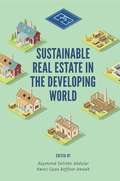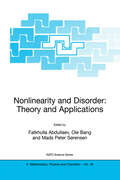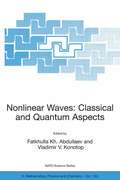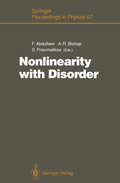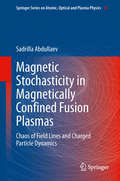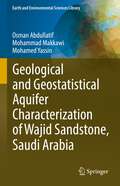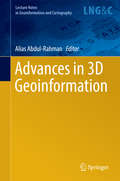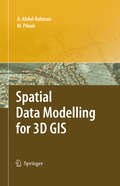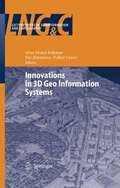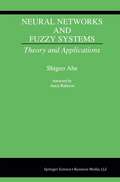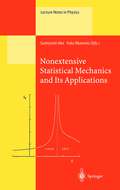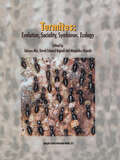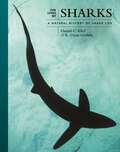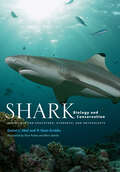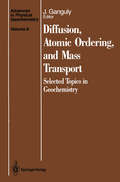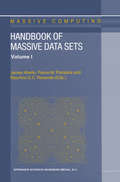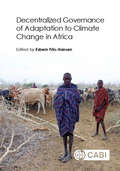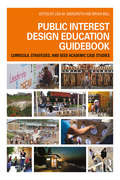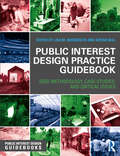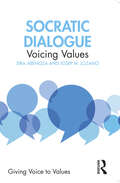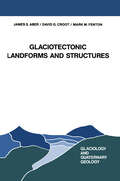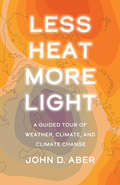- Table View
- List View
Sustainable Real Estate in the Developing World
by Raymond Talinbe Abdulai Kwasi Gyau Baffour AwuahMany years have elapsed since the start of sustainability revolution, yet there is still a lack of diverse collections offering in-depth analysis of sustainability principles applied to real estate in the developing world. Sustainable Real Estate in the Developing World offers a perfect and ideal synthesis of works that examine sustainability within various facets of real estate and urban development in the developing world. Harnessing multi- and inter-disciplinary perspectives, this book discusses the fundamental issues of the complex nexus between the built environment and sustainable development, thereby illuminating how they are affecting and will potentially affect each other. The book highlights rich and practical experiences, challenges, and best practices of over ten countries in four continents, with contributors proffering solutions around topics such as the following: sustainable development goals and the urban agenda; housing development in the context of environmental sustainability; demand for sustainable features in commercial real estate; urban development, land use changes, and environmental impacts in cities; urbanization, environmental externalities, and house prices; building information modelling adaptability for sustainable residential real estate development; and COVID-19 and sustainable development. This collection is useful to academics, researchers, and students in all the built environment disciplines, as well as to policy makers, practitioners, professional bodies and the international donor community.
Nonlinearity and Disorder: Theory and Applications (NATO Science Series II: Mathematics, Physics and Chemistry #45)
by Fatkhulla Abdullaev Ole Bang Mads Peter SørensenProceedings of the NATO Advanced Research Workshop, Tashkent, Uzbekistan, 2-6 October 2001
Nonlinear Waves: Classical and Quantum Aspects (NATO Science Series II: Mathematics, Physics and Chemistry #153)
by Fatkhulla Abdullaev Vladimir V. KonotopLeading scientists discuss the most recent physical and experimental results in the physics of Bose-Einstein condensate theory, the theory of nonlinear lattices (including quantum and nonlinear lattices), and nonlinear optics and photonics. Classical and quantum aspects of the dynamics of nonlinear waves are considered. The contributions focus on the Gross-Pitaevskii equation and on the quantum nonlinear Schrödinger equation. Recent experimental results on atomic condensates and hydrogen bonded systems are reviewed. Particular attention is given to nonlinear matter waves in periodic potential.
Nonlinearity with Disorder: Proceedings of the Tashkent Conference, Tashkent, Uzbekistan, October 1–7, 1990 (Springer Proceedings in Physics #67)
by Fatkulla Abdullaev Alan R. Bishop Stephanos PnevmatikosIn the past three decades there has been enormous progress in identifying the essential role that nonlinearity plays in physical systems, including supporting soliton-like solutions and self-trapped sxcitations such as polarons. during the same period, similarly impressive progress has occurred in understanding the effects of disorder in linear quantum problems, especially regarding Anderson localization arising from impurities, random spatial structures, stochastic applied fields, and so forth. These striking consequences of disorder, noise and nonlinearity frequently occur together in physical systems. Yet there have been only limited attempts to develop systematic techniques which can include all of these ingredients, which may reinforce, complement or frustrate each other. This book contains a range of articles which provide important steps toward the goal of systematic understanding and classification of phenomenology. Experts from Australia, Europe, Japan, USA, and the USSR describe both mathematical and numerical techniques - especially from soliton and statistical physics disciplines - and applicaations to a number of important physical systems and devices, including optical and electronic transmission lines, liquid crystals, biophysics and magnetism.
Magnetic Stochasticity in Magnetically Confined Fusion Plasmas: Chaos of Field Lines and Charged Particle Dynamics (Springer Series on Atomic, Optical, and Plasma Physics #78)
by Sadrilla AbdullaevThis is the first book to systematically consider the modern aspects of chaotic dynamics of magnetic field lines and charged particles in magnetically confined fusion plasmas. The analytical models describing the generic features of equilibrium magnetic fields and magnetic perturbations in modern fusion devices are presented. It describes mathematical and physical aspects of onset of chaos, generic properties of the structure of stochastic magnetic fields, transport of charged particles in tokamaks induced by magnetic perturbations, new aspects of particle turbulent transport, etc. The presentation is based on the classical and new unique mathematical tools of Hamiltonian dynamics, like the action--angle formalism, classical perturbation theory, canonical transformations of variables, symplectic mappings, the Poincaré-Melnikov integrals. They are extensively used for analytical studies as well as for numerical simulations of magnetic field lines, particle dynamics, their spatial structures and statistical properties. The numerous references to articles on the latest development in the area are provided. The book is intended for graduate students and researchers who interested in the modern problems of magnetic stochasticity in magnetically confined fusion plasmas. It is also useful for physicists and mathematicians interested in new methods of Hamiltonian dynamics and their applications.
Construction of Mappings for Hamiltonian Systems and Their Applications (Lecture Notes in Physics #691)
by Sadrilla S. AbdullaevBased on the method of canonical transformation of variables and the classical perturbation theory, this innovative book treats the systematic theory of symplectic mappings for Hamiltonian systems and its application to the study of the dynamics and chaos of various physical problems described by Hamiltonian systems. It develops a new, mathematically-rigorous method to construct symplectic mappings which replaces the dynamics of continuous Hamiltonian systems by the discrete ones. Applications of the mapping methods encompass the chaos theory in non-twist and non-smooth dynamical systems, the structure and chaotic transport in the stochastic layer, the magnetic field lines in magnetically confinement devices of plasmas, ray dynamics in waveguides, etc. The book is intended for postgraduate students and researches, physicists and astronomers working in the areas of plasma physics, hydrodynamics, celestial mechanics, dynamical astronomy, and accelerator physics. It should also be useful for applied mathematicians involved in analytical and numerical studies of dynamical systems.
Geological and Geostatistical Aquifer Characterization of Wajid Sandstone, Saudi Arabia (Earth and Environmental Sciences Library)
by Osman Abdullatif Mohammad Makkawi Mohamed YassinThe book summarizes research work on the Wajid Sandstone, which provides integrated field and laboratory data to enable a detailed description of this unit including a facies analysis, porosity data, as well as permeability data to establish aquifer models. Detailed facies analysis at outcrop scale are supported by vertical and lateral sedimentological sections, facies and environmental analysis and supplemented by detailed laboratory petrographical and petrophysical data. The analysis and interpretation of the outcrop analog models include the reconstruction of the stratigraphic architecture at outcrop scale. Moreover, the results were described statistically, analyzed and eventually establish an outcrop-based aquifer model analogue. The book benefits undergraduate, graduate and researchers working on applied sedimentological studies, hydrogeology, statistical and geostatistical analysis and modeling.
Advances in 3D Geoinformation (Lecture Notes in Geoinformation and Cartography)
by Alias Abdul-RahmanThe book presents a collection of accepted papers from the 3DGeoinfo 2015 international conference held in Kuala Lumpur, Malaysia from October 28 – 30, 2015. All papers underwent double-blind review by experts from around the globe. The conference brought together pioneering international researchers and practitioners to facilitate the dialogue on emerging topics in the field of 3D geo-information. The focus areas include: - Data Collection and Modeling: advanced approaches for 3D data collection, reconstruction and methods for representation- Data Management: topological, geometrical and network models for maintenance of 3D geoinformation- Data Analysis and Visualization: frameworks for representing 3D spatial relationships, 3D spatial analysis and algorithms for navigation, interpolation, advanced VR, AR and MR visualisation, as well as 3D visualization on mobile devices- 3D Applications: city models, Cadastre, LBS, etc.
Spatial Data Modelling for 3D GIS
by Alias Abdul-Rahman Morakot PiloukThis book covers fundamental aspects of spatial data modelling specifically on the aspect of three-dimensional (3D) modelling and structuring. Realisation of "true" 3D GIS spatial system needs a lot of effort, and the process is taking place in various research centres and universities in some countries. The development of spatial data modelling for 3D objects is the focus of this book.
Innovations in 3D Geo Information Systems (Lecture Notes in Geoinformation and Cartography)
by Alias Abdul-Rahman Sisi Zlatanova Volker CoorsThis book covers various aspects of spatial data modelling specifically regarding three-dimensional (3D) modelling and structuring. The realization of "true" 3D geoinformation spatial systems requires a high input, and the developmental process is taking place in various research centers and universities around the globe. The development of such systems and solutions, including the modelling theories are presented in this book.
Neural Networks and Fuzzy Systems: Theory and Applications
by Shigeo AbeNeural Networks and Fuzzy Systems: Theory and Applications discusses theories that have proven useful in applying neural networks and fuzzy systems to real world problems. The book includes performance comparison of neural networks and fuzzy systems using data gathered from real systems. Topics covered include the Hopfield network for combinatorial optimization problems, multilayered neural networks for pattern classification and function approximation, fuzzy systems that have the same functions as multilayered networks, and composite systems that have been successfully applied to real world problems. The author also includes representative neural network models such as the Kohonen network and radial basis function network. New fuzzy systems with learning capabilities are also covered. The advantages and disadvantages of neural networks and fuzzy systems are examined. The performance of these two systems in license plate recognition, a water purification plant, blood cell classification, and other real world problems is compared.
Nonextensive Statistical Mechanics and Its Applications (Lecture Notes in Physics #560)
by Sumiyoshi Abe Yuko OkamotoNonextensive statistical mechanics is now a rapidly growing field and a new stream in the research of the foundations of statistical mechanics. This generalization of the well-known Boltzmann--Gibbs theory enables the study of systems with long-range interactions, long-term memories or multi-fractal structures. This book consists of a set of self-contained lectures and includes additional contributions where some of the latest developments -- ranging from astro- to biophysics -- are covered. Addressing primarily graduate students and lecturers, this book will also be a useful reference for all researchers working in the field.
Termites: Evolution, Sociality, Symbioses, Ecology
by Y. Abe David Edward Bignell T. HigashiThe book is a new compendium in which leading termite scientists review the advances of the last 30 years in our understanding of phylogeny, fossil records, relationships with cockroaches, social evolution, nesting, behaviour, mutualisms with archaea, protists, bacteria and fungi, nutrition, energy metabolism,population and community ecology, soil conditioning, greenhouse gas production and pest status.
The Lives of Sharks: A Natural History of Shark Life (The Lives of the Natural World #7)
by Daniel C. Abel Dr. R. Dean GrubbsA richly illustrated and comprehensive introduction to the world’s sharksSharks are the top predators in many marine ecosystems. But tales of the killer instincts and fearsomely sharp senses of these hunters can obscure their full life histories. In fact, sharks are characterful, exhibit surprisingly complex behaviors, and lead secretive lives full of interest in every type of marine habitat. The Lives of Sharks is a fascinating and beautifully illustrated guide to these iconic marine creatures from two world-renowned experts. This book explores shark physiology, anatomy, behavior, ecology, and evolution, as well as conservation and the impact of human activity on shark populations. With stunning photographs and illustrations, as well as profiles of selected species, this is a comprehensive, authoritative, and inviting introduction to global shark life today.
Shark Biology and Conservation: Essentials for Educators, Students, and Enthusiasts
by Daniel C. Abel R. Dean GrubbsStudies of shark biology have flourished over the last several decades. An explosion of new research methods is leading to a fascinating era of oceanic discovery. Shark Biology and Conservation is an up-to-date, comprehensive overview of the diversity, evolution, ecology, behavior, physiology, anatomy, and conservation of sharks. Written in a style that is detailed but not intimidating by world-renowned shark specialists Dan Abel and Dean Grubbs, it relays numerous stories and insights from their exciting experiences in the field. While explaining scientific concepts in terms that non-specialists and students can understand, Abel and Grubbs reveal secrets that will illuminate even the experts. The text provides readers with a robust and wide range of essential knowledge as it• introduces emerging as well as traditional techniques for classifying sharks, understanding their behavior, and unraveling the mysteries of their evolution;• draws on both established shark science and the latest breakthroughs in the field, from molecular approaches to tracking technologies;• highlights the often-neglected yet fascinating subject of shark physiology, including heart function, sensory biology, digestion, metabolic performance, and reproduction;• addresses big picture ecological questions like "Which habitats do sharks prefer?" and "Where do sharks migrate and for what purpose?";• describes the astonishing diversity of sharks' adaptations to their environment;• discusses which shark conservation techniques do and don't work; and• comments on the use and misuse of science in the study of sharks.Enhanced by hundreds of original color photographs and beautifully detailed line drawings, Shark Biology and Conservation will appeal to anyone who is spellbound by this wondrous, ecologically important, and threatened group, including marine biologists, wildlife educators, students, and shark enthusiasts.
Diffusion, Atomic Ordering, and Mass Transport: Selected Topics in Geochemistry (Advances in Physical Geochemistry #8)
by F. Abel W. L. Brown S. Chakraborty J. W. Downs S. C. Elphick J. Ganguly J. Goldsmith C. M. Graham O. Jaoul R. Joesten M. Kramer J. D. Kubicki A. C. Lasaga C. E. Lesher P. Lichtner M. Morioka H. Nagasawa I. Parsons C.R. II Ross V. Sautter K. Seifert D. WalkerOne of the fundamental objectives of physical geochemistry is to understand the evolution of geochemical systems from microscopic to regional and global scales. At present there seems to be a general recognition of the fact that internal properties of minerals record important aspects of the evolutionary history of their host rocks which may be unraveled by very fine scale observations. A major focus in the development of geochemical research in the last thirty years has been the application of classical thermodynamics to reconstruct the conditions at which the states of quenched mineralogical properties of rocks have equilibrated during the course of their evolution. While these works have funda mentally influenced our understanding ofthe physico-chemical history ofrocks, in recent years petrologists, mineralogists, and geochemists have been making greater efforts towards the application of kinetic theories in order to develop a better appreciation of the temporal details of geochemical processes. The present volume brings together a variety of current research on transport in systems of geochemical interest from atomic to outcrop scales. A major theme is atomic migration or diffusion, and its various manifestations on microscopic and macroscopic scales. Transport in the solid state is controlled by diffusion and is responsible for the states of atomic ordering and relaxation of composi tional zoning in minerals, development of compositional zoning during cooling, exsolution lamellae, and creep.
Handbook of Massive Data Sets (Massive Computing #4)
by James Abello Panos M. Pardalos Mauricio G. C. ResendeThe proliferation of massive data sets brings with it a series of special computational challenges. This "data avalanche" arises in a wide range of scientific and commercial applications. With advances in computer and information technologies, many of these challenges are beginning to be addressed by diverse inter-disciplinary groups, that indude computer scientists, mathematicians, statisticians and engineers, working in dose cooperation with application domain experts. High profile applications indude astrophysics, bio-technology, demographics, finance, geographi cal information systems, government, medicine, telecommunications, the environment and the internet. John R. Tucker of the Board on Mathe matical Seiences has stated: "My interest in this problern (Massive Data Sets) isthat I see it as the rnost irnportant cross-cutting problern for the rnathernatical sciences in practical problern solving for the next decade, because it is so pervasive. " The Handbook of Massive Data Sets is comprised of articles writ ten by experts on selected topics that deal with some major aspect of massive data sets. It contains chapters on information retrieval both in the internet and in the traditional sense, web crawlers, massive graphs, string processing, data compression, dustering methods, wavelets, op timization, external memory algorithms and data structures, the US national duster project, high performance computing, data warehouses, data cubes, semi-structured data, data squashing, data quality, billing in the large, fraud detection, and data processing in astrophysics, air pollution, biomolecular data, earth observation and the environment.
Decentralized Governance of Adaptation to Climate Change in Africa
by Charles Aben Professor Jacob Agea Bernard Bashaasha Sarah Ann D'Haen Esbern Friis-Hansen Mikkel Funder Carol Mweemba Isaac Nakendo Jonas Østergaard Nielsen Professor Imasiku Nyambe James Okiror Julie Fogt Rasmussen Godfrey SuubiTwo perspectives have dominated the social science discourse on climate change adaptation. Firstly, an international narrative among UN and donor agencies of technical and financial support for planned climate change adaptation. Secondly, a significant volume of studies discuss how local communities can undertake their own autonomous adaptation. Effective and sustainable climate adaptation requires a third focus: understanding of the political processes within sub-national institutions that mediate between national and local practices. This book address the knowledge gap that currently exists about the role of district-level institutions in Sub-Saharan Africa in providing an enabling institutional environment for rural climate change adaptation. Key Features: · Analyses the disconnect between national and local policy and practice, and how to overcome it · Analysis of the political ecology of climate change adaptation in 10 diverse rural districts across Sub-Saharan Africa based on evidence from thorough field work · Explains how to improve the efficiency and effectiveness of climate change adaptation programmes by engaging with decentralized local governments and principles of subsidiarity with regards to decision-making and control over financial resources
Public Interest Design Education Guidebook: Curricula, Strategies, and SEED Academic Case Studies (Public Interest Design Guidebooks)
by Lisa M. Abendroth Bryan BellPublic Interest Design Education Guidebook: Curricula, Strategies, and SEED Academic Case Studies presents the pedagogical framework and collective curriculum necessary to teach public interest designers. The second book in Routledge’s Public Interest Design Guidebook series, the editors and contributors feature a range of learning competencies supported by distinct teaching strategies where educational and community-originated goals unite. Written in a guidebook format that includes projects from across design disciplines, this book describes the learning deemed most critical to pursuing an inclusive, informed design practice that meets the diverse needs of both students and community partners. Featured chapter themes include Fundamental Skills, Intercultural Competencies, Engaging the Field Experience, Inclusive Iteration, and Evaluating Student Learning. The book consists of practice-based and applied learning constructs that bridge community-based research with engaged learning and design practice. SEED (Social Economic Environmental Design) academic case studies introduce teaching strategies that reinforce project-specific learning objectives where solving social, economic, and environmental issues unites the efforts of communities, student designers, and educators. This comprehensive publication also contains indices devoted to learning objectives cross-referenced from within the book as well as considerations for educational program development in public interest design. Whether you are a student of design, an educator, or a designer, the breadth of projects and teaching strategies provided here will empower you to excel in your pursuit of public interest design.
Public Interest Design Education Guidebook: Curricula, Strategies, and SEED Academic Case Studies (Public Interest Design Guidebooks)
by Lisa M. Abendroth Bryan BellPublic Interest Design Education Guidebook: Curricula, Strategies, and SEED Academic Case Studies presents the pedagogical framework and collective curriculum necessary to teach public interest designers. The second book in Routledge’s Public Interest Design Guidebook series, the editors and contributors feature a range of learning competencies supported by distinct teaching strategies where educational and community-originated goals unite. Written in a guidebook format that includes projects from across design disciplines, this book describes the learning deemed most critical to pursuing an inclusive, informed design practice that meets the diverse needs of both students and community partners. Featured chapter themes include Fundamental Skills, Intercultural Competencies, Engaging the Field Experience, Inclusive Iteration, and Evaluating Student Learning. The book consists of practice-based and applied learning constructs that bridge community-based research with engaged learning and design practice. SEED (Social Economic Environmental Design) academic case studies introduce teaching strategies that reinforce project-specific learning objectives where solving social, economic, and environmental issues unites the efforts of communities, student designers, and educators. This comprehensive publication also contains indices devoted to learning objectives cross-referenced from within the book as well as considerations for educational program development in public interest design. Whether you are a student of design, an educator, or a designer, the breadth of projects and teaching strategies provided here will empower you to excel in your pursuit of public interest design.
Public Interest Design Practice Guidebook: SEED Methodology, Case Studies, and Critical Issues (Public Interest Design Guidebooks)
by Lisa M. Abendroth Bryan BellPublic Interest Design Practice Guidebook: Seed Methodology, Case Studies, and Critical Issues is the first book to demonstrate that public interest design has emerged as a distinct profession. It provides clear professional standards of practice following SEED (Social Economic Environmental Design) methodology, the first step-by-step process supporting public interest designers. The book features an Issues Index composed of ninety critical social, economic, and environmental issues, illustrated with thirty case study projects representing eighteen countries and four continents, all cross-referenced, to show you how every human issue is a design issue. Contributions from Thomas Fisher, Heather Fleming and David Kaisel, Michael Cohen, Michael P. Murphy Jr. and Alan Ricks, and over twenty others cover topics such as professional responsibility, public interest design business development, design evaluation, and capacity building through scaling, along with many more. Themes including public participation, issue-based design, and assessment are referenced throughout the book and provide benchmarks toward an informed practice. This comprehensive manual also contains a glossary, an appendix of engagement methods, a case study locator atlas, and a reading list. Whether you are working in the field of architecture, urban planning, industrial design, landscape architecture, or communication design, this book empowers you to create community-centered environments, products, and systems.
Socratic Dialogue: Voicing Values (Giving Voice to Values)
by Sira Abenoza Josep M. LozanoGiving Voice to Values is a very important tool that has helped many professionals better align what they do with what they value and believe. This book introduces the methodology of Socratic Dialogue as a complementary set of tools for creating spaces of joint reflection in which one can gain clarity about one’s values and gain the confidence to voice them effectively. Socrates’ main concern was to progressively reach a higher alignment between ideas and actions: that is, to achieve a harmony between what we think, what we say and what we do. The first step to giving voice to our values involves introspection and dialogue with others – which is how we can become aware of what we really think and value. An examined life, Socrates reminds us, is a fulfilled one. Based on the authors' more than ten years’ experience teaching Socratic Dialogue to business and law students, executives and professionals, faculty, incarcerated people and other vulnerable groups, the book provides teachers and practitioners with a roadmap to conceive, design and conduct Socratic Dialogue courses and sessions. It provides context for the method and its adaptation to the challenges of the 21st century. The book also offers guidance on how to structure a Socratic Dialogue classroom, as well as a series of tried-and-true activities and exercises, practical recommendations and testimonies of the transformative impact that dialogue courses have had on participants. The book is of prime interest to professors and educators of business ethics, as well as professional consultants working to help organizations become more responsible and introduce ethical reasoning in their decisions. It also serves as a valuable resource for social educators and practitioners in prisons and rehabilitation units, as well as teachers in primary and secondary education.
Socratic Dialogue: Voicing Values (Giving Voice to Values)
by Sira Abenoza Josep M. LozanoGiving Voice to Values is a very important tool that has helped many professionals better align what they do with what they value and believe. This book introduces the methodology of Socratic Dialogue as a complementary set of tools for creating spaces of joint reflection in which one can gain clarity about one’s values and gain the confidence to voice them effectively. Socrates’ main concern was to progressively reach a higher alignment between ideas and actions: that is, to achieve a harmony between what we think, what we say and what we do. The first step to giving voice to our values involves introspection and dialogue with others – which is how we can become aware of what we really think and value. An examined life, Socrates reminds us, is a fulfilled one. Based on the authors' more than ten years’ experience teaching Socratic Dialogue to business and law students, executives and professionals, faculty, incarcerated people and other vulnerable groups, the book provides teachers and practitioners with a roadmap to conceive, design and conduct Socratic Dialogue courses and sessions. It provides context for the method and its adaptation to the challenges of the 21st century. The book also offers guidance on how to structure a Socratic Dialogue classroom, as well as a series of tried-and-true activities and exercises, practical recommendations and testimonies of the transformative impact that dialogue courses have had on participants. The book is of prime interest to professors and educators of business ethics, as well as professional consultants working to help organizations become more responsible and introduce ethical reasoning in their decisions. It also serves as a valuable resource for social educators and practitioners in prisons and rehabilitation units, as well as teachers in primary and secondary education.
Glaciotectonic Landforms and Structures (Glaciology and Quaternary Geology #5)
by J. S. Aber David G. Croot Mark M. FentonLess Heat, More Light: A Guided Tour of Weather, Climate, and Climate Change
by John D. AberA straightforward and fact-based exploration of how weather happens, how it relates to climate, and how science answers major questions about Earth as a system Climate change is one of the most hotly contested environmental topics of our day. To answer criticisms and synthesize available information, scientists have been driven to devise increasingly complex models of the climate system. This book conveys that the basics of climate and climate change have been known for decades, and that relatively simple descriptions can capture the major features of the climate system and help the general public understand what controls climate and weather, and how both might be changing. Renowned environmental scientist and educator John D. Aber distills what he has learned from a long fascination with weather and climate, the process of science, and the telling of the story of science. This is not a book about policies and politics. Instead, it explores how weather happens, how it relates to climate, and how science has been used to answer major questions about the Earth as a system and inform policies that have reversed environmental degradation. By providing a guided tour of the science of weather, this thoughtful survey will contribute clarity and rationality to the public understanding of climate change.
